A Special Desk
- Carolyn Feenaghty
- Jun 1, 2016
- 5 min read
I decided to become a teacher for students with severe and multiple disabilities over 10 years ago when moving back to New York. It was during a graduate program field trip organized by Hunter College to the workshop at Adaptive Design Association, ADA, that I first learned about the organization and their mission. I appreciated what they had to offer, but my focus at that time was on graduate school and starting my career as a teacher. In 2014, ADA came to school for a consult for a student who needed an arm guard. I explained concerns and shared a vision with the ADA fabricator. A week or two later, a team from ADA returned with a customized arm guard that attached to the student’s chair. The success that followed for the student left me excited and wanting to learn more. I became a volunteer for Adaptive Design Association in October of 2014.
This year, a student in my classroom began using a motorized wheelchair. Hanann’s upgrade to a motorized chair was a natural prompt for me to begin thinking creatively about solutions for our classroom environment and how to make a desk that accommodated the joystick to her chair. I knew the plastic tray we tied to her chair for a work surface was no longer appropriate. As I honed in on my building skills, I took this as an opportunity to put what I have been learning as a volunteer at ADA into practice. In the spirit of ADA’s vision I decided to what better way to introduce adaptive design techniques to my students and colleagues then to bring the building into my classroom.
As a teacher of students with multiple disabilities, there were limitations as to what they could do, but NOT MANY! At the workshop, I created a cardboard template of a desk using sheets of triwall, bandsaw and other tools. It was a simple design. I was fortunate enough to construct this unfinished model surrounded by ADA staff and interns who offered suggestions. Do you want a lip so things can’t fall off the desk? Nope, the student does not need that support. Do you want curved edges? Nope, that will make the edging harder. Well, maybe a heart because they just had a health fair about healthy hearts! This was going to be the student’s project. My construction wasn’t perfect. I needed questions answered about the direction of the grain and whether to put the top of the desk on top of the legs or in between the legs (in between, in case you were wondering). It was a learning experience, for sure. I cut the leg supports before I made sure the table was level and I even made a mistake measuring. These errors were nothing the jigsaw, box cutter, band sander, hot glue or a cardboard box couldn’t fix! I had a desk made out of cardboard.
At first, I wasn’t sure how to plan out the student involvement. By the end, it was built around a curriculum, built, both literally and figuratively. It showed that at least one skill may be addressed by any person. I incorporated student IEP goals into the building process. The student skill became a step in construction and finishing the project.
Materials used: chopsticks sharpened with a pencil sharpener to be used as dowel, glue, plastic ketchup picnic bottle to hold glue, mallet, paper bag, magazines, ruler, sandpaper, credit card, paintbrushes (classroom), classroom paint. (ONLY had to buy primer and polyurethane)
NAILS: the desk needed to be reinforced with nails.
Teacher task: Use a thin screwdriver to make ½” deep holes where cardboard pieces meet.
Student task: Students fill the holes with glue, add the dowel and hammer it in.
Content Areas: social emotional, fine motor, communication, literacy, math
Skills:
Palmar grasp to hold glue bottle,
Picking up items with hands,
Pincer grasp to hold dowel,
Strength needed to squeeze glue bottle,
Putting small items into matching holes,
Strength to hold mallet,
Show function of object to use bottle or mallet,
Wait for a turn,
Request turn,
Reject without throwing by handing it to someone,
Co-active movements and awareness of environment in squeezing air out of bottle or tapping repeatedly (blind or low functioning experience),
Following sequence,
Following safety directions,
Commenting,
Sitting close to peers with hands to self,
Counting nails and holes,
Matching same number,
Determining if need more or is finished.
EDGING: the entire desk needs to be edged
Teacher task: Divide into two groups: tear paper strips and apply edges.
Student task Group 1: Students tear open the bag. Some students rip small pieces freely. Other students hold the ruler tightly (at least keep hand on ruler while staff hold underneath hand,) someone else could tear a strip. Another student grabs and pulls the paper while staff hold the ruler in place.
Student task Group 2: Students pour glue, spread glue, and apply paper to desk.
Content Areas: social emotional, fine motor, communication, literacy, math
Skills:
Choice making (paper group or glue group),
Follow modelled step(s)
Follow sequence of steps
Grasp item for specified amount of time (ie 5 seconds),
Release item voluntarily
Attend to tabletop task any specified amount of time,
Hold object (ruler) without dropping to floor,
Put items into bin (newspaper) instead of throwing to floor,
Reach to request paper
Use two hands to complete task (one on ruler, one on paper)
Grasp glue,
Squeeze glue,
Stop squeezing at appropriate time or when directed,
Perform function of object in pouring glue,
Grasp card
Spread glue
Bring hand holding card to midline
Pick up a piece of paper
Put on directed spot
Push paper down
Request a turn
Commenting
Direct start or stop/ more or finished
Understand vocabulary some, less, more, all, none
Problem solve on whether more paper is needed to edge, or glue to add
Tolerate sensory experience of glue on hands
Appropriately reject glue on hands
Request to wash hands
Use vocab dirty, want, glue, turn, finished, wow,
Show interest in activity by looking or gesturing toward project
Edging Group 1
Edging Group 2
PAINTING AND DESIGN: the desk needs the final touch.
Teacher task: Ask for local volunteer artist or friends to join the class for an hour to paint a design on the sides or top. Remember to consider if design may become a distraction if in student’s view while working)
Student task: Make choices
Content Areas: ELA, communication, social
Skill Area:
Select a category for design (food, animals, toys, weather, etc)
Select pictures from that category by pointing or verbalizing or eye gazing to picture!
Conduct internet search to find images
About the Author

Carolyn Feenaghty is a Special Education teacher with the New York City Department of Education who insists that her students excel. When they achieve what is expected of them, she raises the bar and turns herself inside out finding ways to help them reach the new goal. After a whole day of classroom teaching, she comes to ADA to help in our workshop. One of Carolyn’s favorite volunteer tasks is edging -- covering raw edges of the cardboard with paper tape to seal and protect. “I find it really relaxing,” says Carolyn.






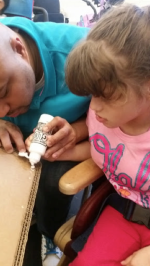

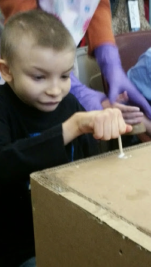

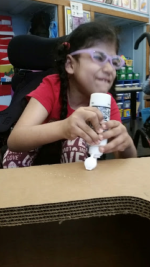








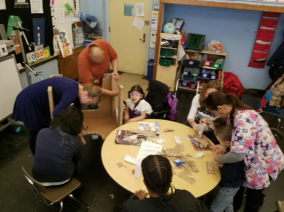



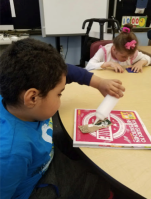
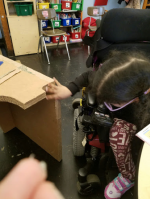
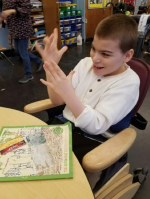


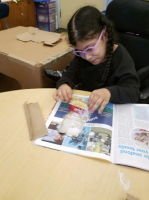


















Comments